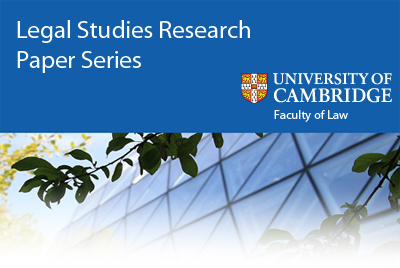 The Faculty has published Volume 7 Number 5 of the University of Cambridge Faculty of Law Legal Studies Research Paper Series on SSRN.
The Faculty has published Volume 7 Number 5 of the University of Cambridge Faculty of Law Legal Studies Research Paper Series on SSRN.
This issue includes the following articles:
Henning Grosse Ruse-Khan, Kathleen Liddell and Michael Waibel: Amicus Curiae Submission in NAFTA Proceedings Eli Lilly v. Canada (13/2016)
This amicus brief was submitted to the NAFTA arbitral tribunal in Eli Lilly v. Canada (ICSID Case No. UNCT/14/2). The arbitration arises out of the decisions by Canadian courts to invalidate two of Eli Lilly’s pharmaceutical patents. The case involves issues of significant public interest because the tribunal’s decision is likely to impact on the legal regimes governing pharmaceutical patent protection in Canada and many other countries. Relatedly, it also bears upon international issues of access to medicines and public health. In particular, findings made in this arbitration are likely to affect, the ability and willingness of countries around the world to use the acknowledged flexibilities of the international intellectual property system, in particular under the TRIPS Agreement, for the purpose of public health and access to medicines. It will also increase the likelihood of similar investment law challenges being brought by IP owners dissatisfied by domestic courts’ decisions on the validity of their patents. This will be a new and concerning development; to date intellectual property norms have only been challenged at an international level in state-to-state proceedings.
The Brief examines, amongst other issues:
- the scope of Canada’s obligations under NAFTA Articles 1105 and its relationship with both domestic and international intellectual property laws;
- the intersection of NAFTA’s standards of protection, in particular fair and equitable treatment (FET) with Canada’s domestic patent law;
- the relationship between NAFTA Chapter 17, the TRIPs Agreement and the Patent Cooperation Treaty;
- the appropriate standard of review for judicial conduct;
- the importance of patent law flexibilities; and
- the frequency of patent invalidations.
Christopher Kuner: Reality and Illusion in EU Data Transfer Regulation Post Schrems (14/2016)
In Schrems v. Data Protection Commissioner, the Court of Justice of the European Union invalidated the EU-US Safe Harbour arrangement allowing personal data to be transferred to the US. The judgment affirms the fundamental right to data protection, defines an adequate level of data protection for international data transfers under EU law, and extends data protection rights to third countries, all based on the EU Charter of Fundamental Rights. The judgment is a landmark in the Court’s data protection case law, and illustrates the tension between the high level of legal protection for data transfers in EU law and the illusion of protection in practice. The judgment has undermined the logical consistency of the other legal bases for data transfer besides the Safe Harbour, and reactions to it have largely been based on formalism or data localization measures that are unlikely to provide real protection. Schrems also illustrates how many legal disagreements concerning data transfers are essentially political arguments in disguise. The EU and the US have since agreed on a replacement for the Safe Harbour (the EU-US Privacy Shield), the validity of which will likely be tested in the Court. It is crucial for data transfer regulation to go beyond formalistic measures and legal fictions, in order to move regulation of data transfers in EU law from illusion to reality.
Jacob Eisler: Judicial Perceptions of Electoral Psychology and the Deep Patterns of Campaign Finance Law (15/2015)
Why has American campaign finance law long suffered from doctrinal confusion and sparked bitter ideological conflict? This article demonstrates that these attributes are rooted in a judicial dispute over the cognitive and social characteristics of central actors in elections.
The article unpacks the foundations of campaign finance law through a multi-tiered analysis of case texts. It first explicates the doctrinal deficiencies that riddle the Supreme Court’s campaign finance jurisprudence. These flaws reflect the Court’s clumsy engagement with democratic theory, which has been an unrecognized driver of campaign finance law and the wellspring of the partisan dispute. Conservatives assert that the pillar of democracy is free participation in the marketplace of information, and subsequently reject restriction of campaign financing even when advanced in the name of anti-corruption. Conversely, liberals perceive democracy as vulnerable to systemic corruption from plutocratic influences and thus endorse regulatory oversight of campaign spending.
The latter half of the article excavates the origins of this conflict: the factions adopt divergent positions on the cognitive and social attributes of political actors (voters, candidates, donors, and public officials). As these positions inform the factions’ theories of democracy, the campaign finance quagmire can be traced to political and psychological assumptions present in the cases. Progress in campaign finance law demands revision of the relationship between these assumptions and contemporary electoral realities.
Alison Jones and Albertina Albors-Llorens: The Images of the ‘Consumer’ in EU Competition Law (17/2016)
This paper examines the different images of the ‘consumer(s)’ drawn in EU Competition Law and seeks to identify exactly who those consumers are.
The competition provisions in the TFEU make several express references to consumers without defining the term. Further, a number of allusions to the consumer can be found in the jurisprudence, secondary legislation and the Commission’s guidance documents. These sources suggest, at first sight, that, as is the case in other areas of EU law, the image of the consumer painted by the law is not a uniform or monochrome one, but a colourful one, evoking a landscape of diversity. This chapter considers this diversity of images and argues that when the apparently differing approaches are set within the broader context in which they are used, and against the overarching goals of EU Competition law, it can be seen that the interpretations adopted in each scenario are not in fact inconsistent with one another. Rather, the question of how the consumer is characterised and defined in the competition law sphere is dependent upon the context and the part of the competition law process in which it is used. In particular, the meaning of the term ‘consumer’ adopted fluctuates depending upon whether it is used in the context of:
(i) describing the objectives of the competition laws and the consumers that those competition law rules are designed to protect;
(ii) identifying persons during the process of determining whether the competition law rules have been infringed and, consequently, their objectives thwarted: for example, when deploying analytical tools or identifying whether particular persons, or groups of persons, have been harmed or benefited by the conduct at issue; or
(iii) referring to some of the actors who participate in the enforcement of the substantive competition provisions.
The chapter concludes by proposing a taxonomy of the images of the consumer(s) and by recognising that, despite the overarching objective of EU Competition Law, the final consumer is more likely to be a distant, rather than a direct, beneficiary of the rules.
Interested readers can browse the Working Paper Series at SSRN, or sign up to subscribe to distributions of the the e-journal.


 Facebook
Facebook  X/Twitter
X/Twitter  Instagram
Instagram  YouTube
YouTube  Flickr
Flickr  LinkedIn
LinkedIn